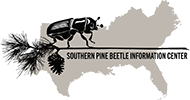Abstract Myotis septentrionalis (Northern Long-eared Bat) is a federally threatened insectivorous bat facing devastating population declines due to white-nose syndrome (WNS). Our study provides pre-WNS (2009) capture rates and roosting-behavior data for Northern...
2011-2020 Publications
Synchrony, Weather, and Cycles in Southern Pine Beetle (Coleoptera: Curculionidae)
Abstract Spatial synchrony and cycles are common features of forest insect pests, but are often studied as separate phenomenon. Using time series of timber damage caused by Dendroctonus frontalis Zimmermann (Coleoptera: Curculionidae) (southern pine beetle) in 10...
The Role of Multimodal Signals in Species Recognition Between Tree-Killing Bark Beetles in a Narrow Sympatric Zone
Abstract When related species coexist, selection pressure should favor evolution of species recognition mechanisms to prevent interspecific pairing and wasteful reproductive encounters. We investigated the potential role of pheromone and acoustic signals in species...
Semiochemical Emission From Individual Galleries of the Southern Pine Beetle, (Coleoptera: Curculionidae: Scolytinae), Attacking Standing Trees
Abstract We collected, identified, and quantified volatiles arising from individual gallery entrances of the monogamous bark beetle Dendroctonus frontalis Zimmermann. Samples were collected while the insects were mass attacking mature loblolly pines (Pinus taeda L.)...
Factors Related with Nonindustrial Private Forest Landowners’ Forest Conversion Decision in Cumberland Plateau, Tennessee
Abstract Previous studies of nonindustrial private forest (NIPF) landowners examined factors affecting their management decisions such as harvesting, selling land, and enrolling in cost-share programs. Converting forestland into nonforest uses, however, is yet another...
Southern Pine Beetle Infestations in Relation to Forest Stand Conditions, Previous Thinning, and Prescribed Burning: Evaluation of the Southern Pine Beetle Prevention Program
Abstract Since 2003, the Southern Pine Beetle Prevention Program (SPBPP) (a joint effort of the USDA Forest Service and Southern Group of State Foresters) has encouraged and provided cost-share assistance for silvicultural treatments to reduce stand/forest...
Discrimination of Odors Associated With Conspecific and Heterospecific Frass by Sibling Species Dendroctonus frontalis (Coleoptera: Curculionidae: Scolytinae) and Dendroctonus mesoamericanus (Coleoptera: Curculionidae: Scolytinae)
Abstract In the Central American region, the aggressive, sibling bark beetles Dendroctonus frontalis Zimmermann (Coleoptera: Curculionidae: Scolytinae) and Dendroctonus mesoamericanus Armendáriz-Toledano & Sullivan (Coleoptera: Curculionidae: Scolytinae) commonly...
Responses by Dendroctonus frontalis and Dendroctonus mesoamericanus (Coleoptera: Curculionidae) to Semiochemical Lures in Chiapas, Mexico: Possible Roles of Pheromones During Joint Host Attacks
Abstract In southern Mexico and Central America, the southern pine beetle Dendroctonus frontalis Zimmermann (Coleoptera: Curculionidae: Scolytinae) commonly colonizes host trees simultaneously with Dendroctonus mesoamericanus Armendariz-Toledano and Sullivan, a...
Incorporating Carbon Storage into the Optimal Management of Forest Insect Pests: A Case Study of the Southern Pine Beetle (Dendroctonus Frontalis Zimmerman) in the New Jersey Pinelands
Abstract Forest insect pest disturbance is increasing in certain areas of North America as many insect species, such as the southern pine beetle, expand their range due to a warming climate. Because insect pests are beginning to occupy forests that are managed for...
